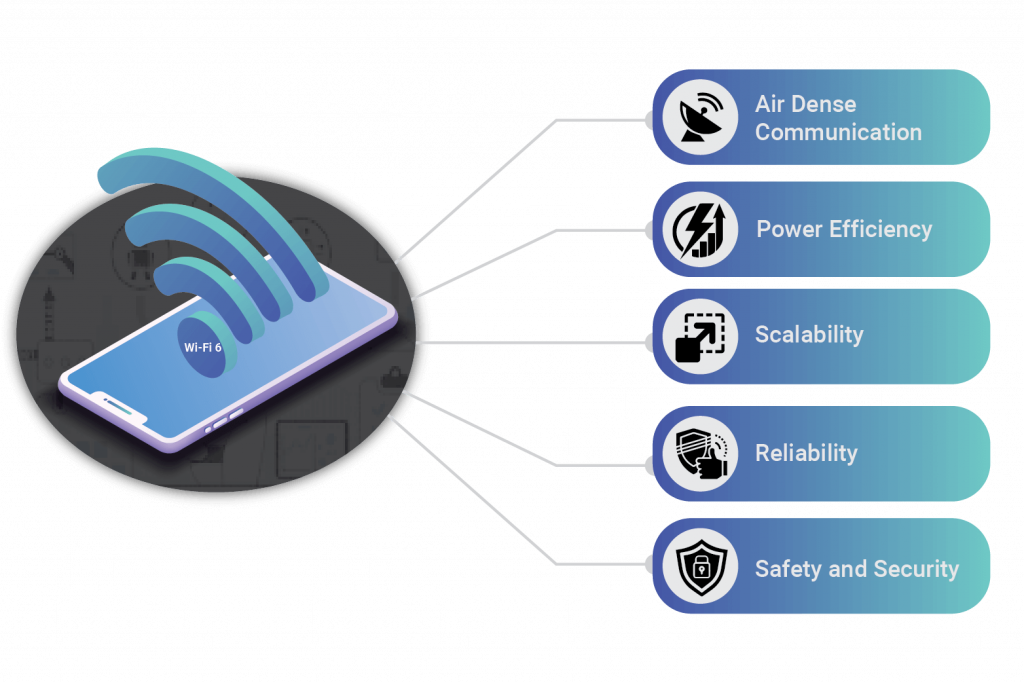Wi-Fi is one of the most widespread technologies ever invented, providing faster and more reliable connections. The latest generation Wi-Fi connectivity technology, i.e., Wi-Fi 6 or 802.11ax along with the 5G cellular network will change the way we interact with each other, even reshape the way smart devices use to communicate. Compared to any other generation, Wi-Fi 6 delivers better reliability with the greatest security and provides support on various devices. As the various amendments are ratified by IEEE, let us tour to utilize the latest IEEE 802.11ax variance with the fast-growing IoT.
Why does Wi-Fi 6 Provide More Value in Applications Compared to the Predecessor Versions?
- Higher Data Rates: When calculating the highest possible data rate, one needs to consider the type of MCS chosen, number of spatial streams supported, spectrum width to use, and guard interval between the symbols. The user will experience the data rate up to 9.6gbps with Wi-Fi 6 by adopting two new Modulation and Coding Schemes (MCS10~MCS11) 1024QAM, improved symbol period (12.8 µs), reduced subcarrier width (78.125 kHz), maximum 8 spatial streams, channel bandwidth (160MHz) and allowed multi-range guard intervals (0.8 µs, 1.6 µs or 3.2 µs) than 802.11ac
- Superior Traffic Management: The most challenging function within the network is to effectively distribute the inconsistent, differently loaded payloads within the provided bandwidth. Wi-Fi 6 is utilizing the MU-MIMO for both the downlink as well as the uplink communication between the station and an access point
- Along with the MU-MIMO, Wi-Fi 6 promoted the use of OFDMA with an increased number of modulated data subcarriers (234) in a single 20MHz channel. With the downlink OFDMA, access points can group a subcarrier to accommodate data for multiple stations. This is similar to multiple one-way lanes on roads dedicated to each vehicle
- Similar support in uplink direction with the segregated group of subcarriers per station. This technique eventually reduces the transmission overhead for individual stations and improves the efficiency in addition to allowing lower-sized data packets parallel transmission which is the best suitable advantage of Wi-Fi 6 within the crowded BSS (Basic Service Set). BSS coloring is another mechanism to diversify the traffic in the ESS (Extended Service Set) network
- Boosted Battery Life: Wi-Fi 6 or 802.11ax has come up with a new approach to maintain the power and contention management where an access point can control the wake-up and sleep time for individual station well in advance, known as Target Wake Time (TWT) originally described in the 802.11ah amendment as Wi-Fi – HaLow and improved in Wi-Fi 6. This will improvise doze time for stations and will eventually can sustain more power to operate longer. It also enhances the AP’s performance in terms of the fewer chances of dropped packets as it knows when the station will come back to take its data
- Better Security: It is predicted that Wi-Fi 6 can mandate the use of WPA3 offering Simultaneous Authentication of Equals (SAE) within WPA3-personal and GCMP-256 based protection with optional 192-bit security mode within WPA3-Enterprise. WPA3 uses the latest security method to lessen the brute force attacks, dictionary attacks. WPA3 also mandates the Protective Management Frame (PMF)
- Increased Connected Stations: In an era of increasingly connected devices, networking people are more interested in making the central device capable to serve as many devices as it can, without compromising the fair access to the channel. Wi-Fi 6 is now available to the Industrial IoT (IIOT) networks that can serve almost 9 stations operating at 20Mhz wide channel and 18 stations operating at 40Mhz wide channel simultaneously due to the reduced single subcarrier spacing by 4 than in Wi-Fi 5
How Wi-Fi 6 Addresses the Need of Industrial IoT (IIoT)?
Industries like manufacturing units installed with HMIs-PLC-SCADA, healthcare premises, logistics, mining, oil/gas plants, agriculture all require below minimal parameters which can affect the performance:
- Air Dense Communication: One of the primary goals of Wi-Fi 6 is an efficient transfer within a crowded network. Industries landed over several 10 to 100 acres delivering multiple products depending on hundreds of vendors for a single production. For example, scanning barcodes on the different parts of a product from dedicated machines under the centralized network can be used to report all the related information to the central server. Wi-Fi 6 with critical uplink OFDMA management, centralized devices can take up data from the multiple stations simultaneously by accepting the payloads from dedicated pre-negotiated differently grouped subcarrier channels with the reduced preamble overhead. In the ESS network, Wi-Fi 6’s BSS coloring is the best suitable traffic management scheme for the bigger network
- Power Efficiency: IIoT device application from small payloads to video surveillance to capture the real-time critical data requires a better-managed power-efficient conversation to extend the durability of the device over the years. Taking a regular observation from the IIoT sensors helps us remote machine control and examine maintenance requirements for machineries to timely deliver the outlet. This requires thousands of readings which expect continuous interaction with power-hungry sensors. In addition to beamforming, Wi-Fi 6’s TWT is here to take care of expanding the range of operation with minimal power consumption

- Scalability: Monitoring of critical machinery that must work within defined operational protocol limits like operation temperature, bounded to maximum current allowed, oxidation impact. This requires continuous monitoring and data gathering process with the destined multiple sensors per instrument base. It could be dangerous to be around a boiler machine that is bound to certain heat production. Wi-Fi 6 has scaled up to manage data from more sensors simultaneously though maintaining the uniform data rate per device
- Reliability: One of the key aspects of IIoT is uninterrupted reliable communication. Manipulating the regularly collected data from various sensors for multiple types of equipment leads to raising the early calls of breakage in a whole system. Eventually, it speeds up the process and decreases the chances of unnecessary materialistic delays, and improves reliable delivery. With the UL/DL OFDMA, Wi-Fi 6 can handle the customized and different weighted payload from various equipment using only a single transmit opportunity to just not miss a single event from the multiple sensors with shorter subcarrier width. Wi-Fi 6 never falls apart to provide seamless connectivity with numerous stations
- Safety and Security: Larger the production, more the design drafts that must be confidential even under the same production unit. This requires a safe and secure data exchange between the communicators. In contrast with the other IoT (Internet of Things) technologies, Wi-Fi 6 evaluated its security with the robust WPA3 from all over the years. Continuous improvement in security made the Wi-Fi 6 the best choice for the theft-proof network
About VOLANSYS
With extensive experience in Wi-Fi technology, VOLANSYS works as an extended team of various clients globally to provide platform-independent development for Wi-Fi functionalities on Linux, Android, and FreeRTOS. We enhance and resolve stability, reliability, and connectivity issues across multiple devices. We focus on engaging with the activity to improve the overall performance of Wi-Fi 6 networks to achieve the highest possible rate with optimal power consumption for their onboard applications. That also included the flawless connection establishment between multiple nodes on one go without any communication break in multiple retries.
Here are some of the success stories listed which give an overview of how VOLANSYS helped their client in developing a Wi-Fi-based IoT solution.

About the Author: Radhika Somaiya
Radhika is a working Senior Embedded Engineer at VOLANSYS Technologies with 4 years of association. She has collective expertise in Wired and Wireless Networking, Linux BSP. She is a passionate solution provider for various Networking protocols, wired and wireless Networking stack, Network Testing. She has the experience to develop and support network protocol features for high-speed SDN compliant network ASICs and application integration to NOS.









